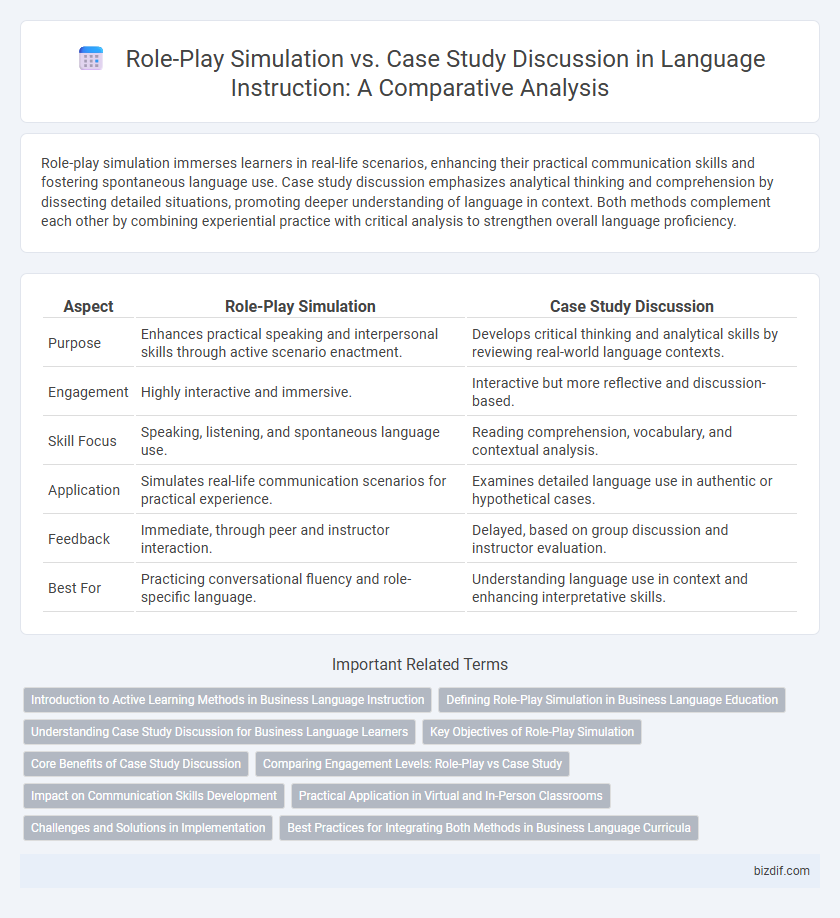Role-play simulation immerses learners in real-life scenarios, enhancing their practical communication skills and fostering spontaneous language use. Case study discussion emphasizes analytical thinking and comprehension by dissecting detailed situations, promoting deeper understanding of language in context. Both methods complement each other by combining experiential practice with critical analysis to strengthen overall language proficiency.
Table of Comparison
| Aspect | Role-Play Simulation | Case Study Discussion |
|---|---|---|
| Purpose | Enhances practical speaking and interpersonal skills through active scenario enactment. | Develops critical thinking and analytical skills by reviewing real-world language contexts. |
| Engagement | Highly interactive and immersive. | Interactive but more reflective and discussion-based. |
| Skill Focus | Speaking, listening, and spontaneous language use. | Reading comprehension, vocabulary, and contextual analysis. |
| Application | Simulates real-life communication scenarios for practical experience. | Examines detailed language use in authentic or hypothetical cases. |
| Feedback | Immediate, through peer and instructor interaction. | Delayed, based on group discussion and instructor evaluation. |
| Best For | Practicing conversational fluency and role-specific language. | Understanding language use in context and enhancing interpretative skills. |
Introduction to Active Learning Methods in Business Language Instruction
Role-play simulation in business language instruction enhances communicative competence by immersing learners in realistic scenarios, fostering spontaneous language use and cultural understanding. Case study discussion promotes analytical thinking and problem-solving skills through collaborative examination of authentic business contexts, encouraging detailed language production and strategic vocabulary application. Both methods activate active learning but differ in interaction style; role-play emphasizes experiential dialogue, while case studies focus on critical analysis and group discussion.
Defining Role-Play Simulation in Business Language Education
Role-play simulation in business language education involves immersive practice where learners enact real-world scenarios to develop conversational fluency and industry-specific communication skills. Unlike case study discussions that analyze written situations, role-play simulations require active interaction and spontaneous language use, enhancing both linguistic competence and cultural understanding. This method promotes experiential learning by replicating authentic business exchanges, thus preparing students for dynamic professional environments.
Understanding Case Study Discussion for Business Language Learners
Case study discussion for business language learners enhances analytical thinking by engaging participants in real-world scenarios that mimic actual business challenges. This method promotes vocabulary expansion and context-based language use, fostering deeper comprehension of industry-specific terminology. Unlike role-play simulation, case study discussion encourages critical evaluation and collaborative problem-solving through group dialogue and reflection.
Key Objectives of Role-Play Simulation
Role-play simulation in language instruction focuses on enhancing practical communication skills, promoting active learner engagement, and fostering real-time problem-solving abilities. It allows learners to practice authentic conversational scenarios, improving fluency and cultural competence. Role-play simulation also develops critical thinking and adaptability crucial for effective language use in diverse contexts.
Core Benefits of Case Study Discussion
Case study discussion enhances critical thinking by allowing learners to analyze real-world scenarios and apply theoretical knowledge to practical situations. It fosters collaborative learning through group analysis and diverse perspectives, deepening understanding of complex concepts. This method also develops problem-solving skills by encouraging participants to evaluate outcomes and consider multiple strategies within a controlled environment.
Comparing Engagement Levels: Role-Play vs Case Study
Role-play simulation fosters active participation by immersing learners in real-life scenarios, which significantly boosts engagement and retention compared to traditional case study discussions. Case studies primarily involve analytical thinking and reflection, often resulting in lower emotional involvement and interaction. Research indicates that role-play increases experiential learning and motivation, enhancing communication skills more effectively than case-based methods.
Impact on Communication Skills Development
Role-play simulation enhances communication skills development by providing immersive, interactive scenarios that mimic real-life conversations, fostering active listening, empathy, and adaptive response strategies. Case study discussions promote analytical thinking and verbal articulation of complex ideas, enabling learners to practice structured communication and critical reasoning in a collaborative environment. Both methods improve communicative competence, but role-play offers experiential learning benefits that directly translate to spontaneous interpersonal interactions.
Practical Application in Virtual and In-Person Classrooms
Role-play simulation enhances practical application by immersing students in real-life scenarios, fostering active problem-solving and communication skills in both virtual and in-person classrooms. Case study discussions develop analytical thinking and theoretical understanding but may lack the interactive, hands-on experiences provided by role-play activities. Virtual platforms support dynamic role-play through breakout rooms and interactive tools, while in-person settings offer immediate feedback and non-verbal communication cues critical for skill development.
Challenges and Solutions in Implementation
Role-play simulation often faces challenges such as participant discomfort, unrealistic scenarios, and resource intensity, requiring structured pre-briefing and debriefing sessions to enhance engagement and realism. Case study discussions encounter difficulties in ensuring relevance and depth, demanding carefully curated content and guided facilitation techniques to stimulate critical thinking. Effective implementation depends on balancing these approaches through adaptive strategies, combining immersive interaction with analytical reflection to optimize language learning outcomes.
Best Practices for Integrating Both Methods in Business Language Curricula
Role-play simulation enhances practical communication skills by immersing learners in real-life business scenarios, fostering spontaneity and cultural nuance. Case study discussion promotes critical thinking and analytical abilities by examining complex business problems and diverse perspectives. Integrating both methods in business language curricula maximizes learner engagement and skill application, balancing experiential learning with reflective analysis to prepare students for dynamic workplace interactions.
Role-play simulation vs Case study discussion Infographic

 bizdif.com
bizdif.com